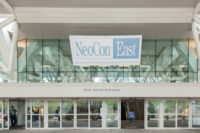Originally built from 1923 to 1927 as the headquarters for New York Telephone, the Barclay-Vesey Building was severely damaged during the September 11 attacks on the World Trade Center complex. On two of the building's facades, much of the carved limestone was shattered well beyond repair.
Now, a year and a half after the attacks, the carved Indiana limestone is being thoughtfully replicated by artisans at Petrillo Stone Corp. in Mt. Vernon, NY. Using the surviving stonework as their model to replicate the destroyed carvings, a team of workers is dedicated to ensuring that the facade will be rebuilt by September of this year.
The carving team at Petrillo Stone Corp. is relying on traditional stoneworking skills and methods to replicate the stonework in the style that their predecessors achieved 80 years ago. "We wanted to keep everything as close to the original as possible," said carver Bob Carpenter. "The [original carvers] were brilliant."
And so the work being done at Petrillo's shop is not being executed by machinery as much as it is being crafted by hand. A walk through the facility reveals carvers working primarily with hand chisels and routers, their faces expressing the concentration necessary for the task at hand -- much like the expressions surely worn by the original stonecarvers back in the 1920s.
But even though the handcarving is most certainly the key aspect to replicating the stonework at the Barclay-Vesey Building, modern technology is also playing a hand.
The first step in replicating the stonework was to take photographs and create molds of the existing stonework at the building. The images of the stonework are then used to make latex matting that outlines the surface designs, and this matting is placed over the slabs so they can be sandblasted in the same way that stone monuments are processed. A sandblasting unit then achieves the necessary depth of the designs. Next, the artisans use routers set at a low speed to make sharper corners on the surface designs. By taking these steps, the carvers are able to complete the detailing of what is already dimensioned, and they do not have to spend an excessive amount of time removing surface material.
The Barclay-Vesey Building is an example of the excellence that can be achieved by combining old-fashioned stoneworking skill with some modern advancements. The result will be a building crafted to the same quality as the original, with greater efficiency. In this day of advanced Computer Numerically Controlled machines, endless Internet communication and high-tech installation products, it is interesting to note that raw stoneworking ability still plays an integral role in the natural stone industry.

